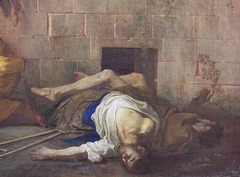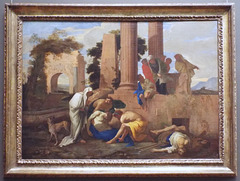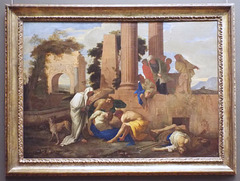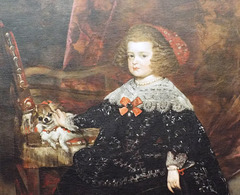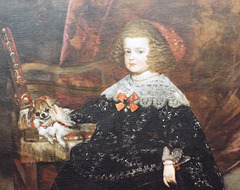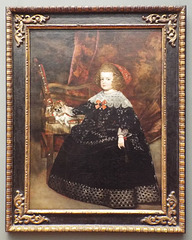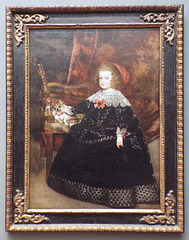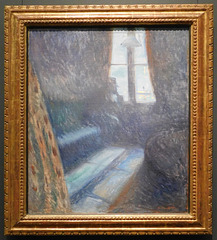LaurieAnnie's photos
Races in the Bois de Boulogne by Manet in the Metr…
| |
|
Title: The Races in the Bois de Boulogne
Artist: Edouard Manet (French, Paris 1832–1883 Paris)
Date: 1872
Culture: French
Medium: Oil on canvas
Dimensions: 28 3/4 × 37 in. (73 × 94 cm)
Framed: 41 1/8 × 48 1/16 × 4 1/2 in. (104.5 × 122 × 11.5 cm)
Classification: Paintings
Credit Line: Private collection
Étienne Moreau-Nélaton, a champion of Manet’s art and a collector who owned, among other works, his Déjeuner sur l’herbe, pointed out that the artist owed his interest in the subject of the racetrack to Degas. Degas’s drawing of Manet at the races, shown in this gallery, confirms that the two artists were there together. Manet may have corroborated this evidence; the spectator in the top hat at the bottom edge of this painting is possibly Degas.
Text from: www.metmuseum.org/art/collection/search/851694
At the Races: The Start by Degas in the Metropolit…
| |
|
Title: At the Races: The Start
Artist: Edgar Degas (French, Paris 1834–1917 Paris)
Date: ca. 1860–62
Geography: Country of Origin France
Culture: French
Medium: Oil on canvas
Dimensions: 13 × 18 1/2 in. (33 × 47 cm)
Frame: 18 × 23 1/2 × 2 3/4 in. (45.7 × 59.7 × 7 cm)
Classification: Paintings
Credit Line: Harvard Art Museums/Fogg Museum, Bequest of Annie Swan Coburn (1934.30)
Although Degas rarely painted outdoors, beginning in the early 1860s he revealed a keen interest in racetrack scenes. For this early painting, he modeled the anatomical features and poses of the horses on both British prints and the work of the Romantic painter Théodore Géricault. The horse at the far left, positioned with its head and front leg raised high, appears to be performing a dressage exercise rather than preparing for a race, perhaps indicating the artist’s reliance on a published source. Degas’s depiction of horses in motion changed drastically over his career, particularly after the 1887 publication of Eadweard Muybridge’s chronophotographic series recording the locomotion of a galloping horse.
Text from: www.metmuseum.org/art/collection/search/844641
At the Races: The Start by Degas in the Metropolit…
| |
|
Title: At the Races: The Start
Artist: Edgar Degas (French, Paris 1834–1917 Paris)
Date: ca. 1860–62
Geography: Country of Origin France
Culture: French
Medium: Oil on canvas
Dimensions: 13 × 18 1/2 in. (33 × 47 cm)
Frame: 18 × 23 1/2 × 2 3/4 in. (45.7 × 59.7 × 7 cm)
Classification: Paintings
Credit Line: Harvard Art Museums/Fogg Museum, Bequest of Annie Swan Coburn (1934.30)
Although Degas rarely painted outdoors, beginning in the early 1860s he revealed a keen interest in racetrack scenes. For this early painting, he modeled the anatomical features and poses of the horses on both British prints and the work of the Romantic painter Théodore Géricault. The horse at the far left, positioned with its head and front leg raised high, appears to be performing a dressage exercise rather than preparing for a race, perhaps indicating the artist’s reliance on a published source. Degas’s depiction of horses in motion changed drastically over his career, particularly after the 1887 publication of Eadweard Muybridge’s chronophotographic series recording the locomotion of a galloping horse.
Text from: www.metmuseum.org/art/collection/search/844641
Detail of Tobit Burying the Dead by DiLione in the…
| |
|
Title: Tobit Burying the Dead
Artist: Andrea di Lione (Italian, Naples 1610–1685 Naples)
Date: 1640s
Medium: Oil on canvas
Dimensions: 50 1/4 x 68 1/2 in. (127.6 x 174 cm)
Classification: Paintings
Credit Line: Gwynne Andrews Fund, 1989
Accession Number: 1989.225
In the 1640s, the Neapolitan painter Andrea di Lione visited Rome, where he met Nicolas Poussin and Giovanni Benedetto Castiglione, a painter famous for his imaginary architecture and pastoral landscapes. This work’s pronounced classicism—including the careful citation of ancient architecture and its blonde tonality—is indebted to these artists’ influence. The cloaked figure represents the Old Testament character Tobit. A devout Jew, Tobit defied an earthly decree by the local king requiring Jewish people to be buried outside the city walls in favor of divine law concerning respect for the dead.
Text from: www.metmuseum.org/art/collection/search/436891
Detail of Tobit Burying the Dead by DiLione in the…
| |
|
Title: Tobit Burying the Dead
Artist: Andrea di Lione (Italian, Naples 1610–1685 Naples)
Date: 1640s
Medium: Oil on canvas
Dimensions: 50 1/4 x 68 1/2 in. (127.6 x 174 cm)
Classification: Paintings
Credit Line: Gwynne Andrews Fund, 1989
Accession Number: 1989.225
In the 1640s, the Neapolitan painter Andrea di Lione visited Rome, where he met Nicolas Poussin and Giovanni Benedetto Castiglione, a painter famous for his imaginary architecture and pastoral landscapes. This work’s pronounced classicism—including the careful citation of ancient architecture and its blonde tonality—is indebted to these artists’ influence. The cloaked figure represents the Old Testament character Tobit. A devout Jew, Tobit defied an earthly decree by the local king requiring Jewish people to be buried outside the city walls in favor of divine law concerning respect for the dead.
Text from: www.metmuseum.org/art/collection/search/436891
Detail of Tobit Burying the Dead by DiLione in the…
| |
|
Title: Tobit Burying the Dead
Artist: Andrea di Lione (Italian, Naples 1610–1685 Naples)
Date: 1640s
Medium: Oil on canvas
Dimensions: 50 1/4 x 68 1/2 in. (127.6 x 174 cm)
Classification: Paintings
Credit Line: Gwynne Andrews Fund, 1989
Accession Number: 1989.225
In the 1640s, the Neapolitan painter Andrea di Lione visited Rome, where he met Nicolas Poussin and Giovanni Benedetto Castiglione, a painter famous for his imaginary architecture and pastoral landscapes. This work’s pronounced classicism—including the careful citation of ancient architecture and its blonde tonality—is indebted to these artists’ influence. The cloaked figure represents the Old Testament character Tobit. A devout Jew, Tobit defied an earthly decree by the local king requiring Jewish people to be buried outside the city walls in favor of divine law concerning respect for the dead.
Text from: www.metmuseum.org/art/collection/search/436891
Detail of Tobit Burying the Dead by DiLione in the…
| |
|
Title: Tobit Burying the Dead
Artist: Andrea di Lione (Italian, Naples 1610–1685 Naples)
Date: 1640s
Medium: Oil on canvas
Dimensions: 50 1/4 x 68 1/2 in. (127.6 x 174 cm)
Classification: Paintings
Credit Line: Gwynne Andrews Fund, 1989
Accession Number: 1989.225
In the 1640s, the Neapolitan painter Andrea di Lione visited Rome, where he met Nicolas Poussin and Giovanni Benedetto Castiglione, a painter famous for his imaginary architecture and pastoral landscapes. This work’s pronounced classicism—including the careful citation of ancient architecture and its blonde tonality—is indebted to these artists’ influence. The cloaked figure represents the Old Testament character Tobit. A devout Jew, Tobit defied an earthly decree by the local king requiring Jewish people to be buried outside the city walls in favor of divine law concerning respect for the dead.
Text from: www.metmuseum.org/art/collection/search/436891
Detail of Tobit Burying the Dead by DiLione in the…
| |
|
Title: Tobit Burying the Dead
Artist: Andrea di Lione (Italian, Naples 1610–1685 Naples)
Date: 1640s
Medium: Oil on canvas
Dimensions: 50 1/4 x 68 1/2 in. (127.6 x 174 cm)
Classification: Paintings
Credit Line: Gwynne Andrews Fund, 1989
Accession Number: 1989.225
In the 1640s, the Neapolitan painter Andrea di Lione visited Rome, where he met Nicolas Poussin and Giovanni Benedetto Castiglione, a painter famous for his imaginary architecture and pastoral landscapes. This work’s pronounced classicism—including the careful citation of ancient architecture and its blonde tonality—is indebted to these artists’ influence. The cloaked figure represents the Old Testament character Tobit. A devout Jew, Tobit defied an earthly decree by the local king requiring Jewish people to be buried outside the city walls in favor of divine law concerning respect for the dead.
Text from: www.metmuseum.org/art/collection/search/436891
Detail of Tobit Burying the Dead by DiLione in the…
| |
|
Title: Tobit Burying the Dead
Artist: Andrea di Lione (Italian, Naples 1610–1685 Naples)
Date: 1640s
Medium: Oil on canvas
Dimensions: 50 1/4 x 68 1/2 in. (127.6 x 174 cm)
Classification: Paintings
Credit Line: Gwynne Andrews Fund, 1989
Accession Number: 1989.225
In the 1640s, the Neapolitan painter Andrea di Lione visited Rome, where he met Nicolas Poussin and Giovanni Benedetto Castiglione, a painter famous for his imaginary architecture and pastoral landscapes. This work’s pronounced classicism—including the careful citation of ancient architecture and its blonde tonality—is indebted to these artists’ influence. The cloaked figure represents the Old Testament character Tobit. A devout Jew, Tobit defied an earthly decree by the local king requiring Jewish people to be buried outside the city walls in favor of divine law concerning respect for the dead.
Text from: www.metmuseum.org/art/collection/search/436891
Detail of Tobit Burying the Dead by DiLione in the…
| |
|
Title: Tobit Burying the Dead
Artist: Andrea di Lione (Italian, Naples 1610–1685 Naples)
Date: 1640s
Medium: Oil on canvas
Dimensions: 50 1/4 x 68 1/2 in. (127.6 x 174 cm)
Classification: Paintings
Credit Line: Gwynne Andrews Fund, 1989
Accession Number: 1989.225
In the 1640s, the Neapolitan painter Andrea di Lione visited Rome, where he met Nicolas Poussin and Giovanni Benedetto Castiglione, a painter famous for his imaginary architecture and pastoral landscapes. This work’s pronounced classicism—including the careful citation of ancient architecture and its blonde tonality—is indebted to these artists’ influence. The cloaked figure represents the Old Testament character Tobit. A devout Jew, Tobit defied an earthly decree by the local king requiring Jewish people to be buried outside the city walls in favor of divine law concerning respect for the dead.
Text from: www.metmuseum.org/art/collection/search/436891
Detail of Tobit Burying the Dead by DiLione in the…
| |
|
Title: Tobit Burying the Dead
Artist: Andrea di Lione (Italian, Naples 1610–1685 Naples)
Date: 1640s
Medium: Oil on canvas
Dimensions: 50 1/4 x 68 1/2 in. (127.6 x 174 cm)
Classification: Paintings
Credit Line: Gwynne Andrews Fund, 1989
Accession Number: 1989.225
In the 1640s, the Neapolitan painter Andrea di Lione visited Rome, where he met Nicolas Poussin and Giovanni Benedetto Castiglione, a painter famous for his imaginary architecture and pastoral landscapes. This work’s pronounced classicism—including the careful citation of ancient architecture and its blonde tonality—is indebted to these artists’ influence. The cloaked figure represents the Old Testament character Tobit. A devout Jew, Tobit defied an earthly decree by the local king requiring Jewish people to be buried outside the city walls in favor of divine law concerning respect for the dead.
Text from: www.metmuseum.org/art/collection/search/436891
Tobit Burying the Dead by DiLione in the Metropoli…
| |
|
Title: Tobit Burying the Dead
Artist: Andrea di Lione (Italian, Naples 1610–1685 Naples)
Date: 1640s
Medium: Oil on canvas
Dimensions: 50 1/4 x 68 1/2 in. (127.6 x 174 cm)
Classification: Paintings
Credit Line: Gwynne Andrews Fund, 1989
Accession Number: 1989.225
In the 1640s, the Neapolitan painter Andrea di Lione visited Rome, where he met Nicolas Poussin and Giovanni Benedetto Castiglione, a painter famous for his imaginary architecture and pastoral landscapes. This work’s pronounced classicism—including the careful citation of ancient architecture and its blonde tonality—is indebted to these artists’ influence. The cloaked figure represents the Old Testament character Tobit. A devout Jew, Tobit defied an earthly decree by the local king requiring Jewish people to be buried outside the city walls in favor of divine law concerning respect for the dead.
Text from: www.metmuseum.org/art/collection/search/436891
Tobit Burying the Dead by DiLione in the Metropoli…
| |
|
Title: Tobit Burying the Dead
Artist: Andrea di Lione (Italian, Naples 1610–1685 Naples)
Date: 1640s
Medium: Oil on canvas
Dimensions: 50 1/4 x 68 1/2 in. (127.6 x 174 cm)
Classification: Paintings
Credit Line: Gwynne Andrews Fund, 1989
Accession Number: 1989.225
In the 1640s, the Neapolitan painter Andrea di Lione visited Rome, where he met Nicolas Poussin and Giovanni Benedetto Castiglione, a painter famous for his imaginary architecture and pastoral landscapes. This work’s pronounced classicism—including the careful citation of ancient architecture and its blonde tonality—is indebted to these artists’ influence. The cloaked figure represents the Old Testament character Tobit. A devout Jew, Tobit defied an earthly decree by the local king requiring Jewish people to be buried outside the city walls in favor of divine law concerning respect for the dead.
Text from: www.metmuseum.org/art/collection/search/436891
Detail of Maria Teresa, Infanta of Spain by Mazo i…
| |
|
Title: María Teresa (1638–1683), Infanta of Spain
Artist: Juan Bautista Martínez del Mazo (Spanish, Cuenca ca. 1612–1667 Madrid)
Date: ca. 1645
Medium: Oil on canvas
Dimensions: 58 1/4 x 40 1/2 in. (148 x 102.9 cm)
Classification: Paintings
Credit Line: Rogers Fund, 1943
Accession Number: 43.101
Mazo was Velázquez’s assistant and son-in-law, having married his daughter Francisca in 1633, and he mimicked many of the elder artist’s techniques and formats. Here, he portrays María Teresa, daughter of King Philip IV of Spain and future queen of France, at around seven years old. Though she wears a rigid court dress, her lapdog lends the painting an informality typical of Velázquez’s innovative portraits of royal children. The putti faintly visible through the red curtain at upper right reveal that Mazo reused a canvas once painted with an entirely different composition, a common practice in even the highest-level workshops.
Text from: www.metmuseum.org/art/collection/search/437046
Detail of Maria Teresa, Infanta of Spain by Mazo i…
| |
|
Title: María Teresa (1638–1683), Infanta of Spain
Artist: Juan Bautista Martínez del Mazo (Spanish, Cuenca ca. 1612–1667 Madrid)
Date: ca. 1645
Medium: Oil on canvas
Dimensions: 58 1/4 x 40 1/2 in. (148 x 102.9 cm)
Classification: Paintings
Credit Line: Rogers Fund, 1943
Accession Number: 43.101
Mazo was Velázquez’s assistant and son-in-law, having married his daughter Francisca in 1633, and he mimicked many of the elder artist’s techniques and formats. Here, he portrays María Teresa, daughter of King Philip IV of Spain and future queen of France, at around seven years old. Though she wears a rigid court dress, her lapdog lends the painting an informality typical of Velázquez’s innovative portraits of royal children. The putti faintly visible through the red curtain at upper right reveal that Mazo reused a canvas once painted with an entirely different composition, a common practice in even the highest-level workshops.
Text from: www.metmuseum.org/art/collection/search/437046
Maria Teresa, Infanta of Spain by Mazo in the Metr…
| |
|
Title: María Teresa (1638–1683), Infanta of Spain
Artist: Juan Bautista Martínez del Mazo (Spanish, Cuenca ca. 1612–1667 Madrid)
Date: ca. 1645
Medium: Oil on canvas
Dimensions: 58 1/4 x 40 1/2 in. (148 x 102.9 cm)
Classification: Paintings
Credit Line: Rogers Fund, 1943
Accession Number: 43.101
Mazo was Velázquez’s assistant and son-in-law, having married his daughter Francisca in 1633, and he mimicked many of the elder artist’s techniques and formats. Here, he portrays María Teresa, daughter of King Philip IV of Spain and future queen of France, at around seven years old. Though she wears a rigid court dress, her lapdog lends the painting an informality typical of Velázquez’s innovative portraits of royal children. The putti faintly visible through the red curtain at upper right reveal that Mazo reused a canvas once painted with an entirely different composition, a common practice in even the highest-level workshops.
Text from: www.metmuseum.org/art/collection/search/437046
Maria Teresa, Infanta of Spain by Mazo in the Metr…
| |
|
Title: María Teresa (1638–1683), Infanta of Spain
Artist: Juan Bautista Martínez del Mazo (Spanish, Cuenca ca. 1612–1667 Madrid)
Date: ca. 1645
Medium: Oil on canvas
Dimensions: 58 1/4 x 40 1/2 in. (148 x 102.9 cm)
Classification: Paintings
Credit Line: Rogers Fund, 1943
Accession Number: 43.101
Mazo was Velázquez’s assistant and son-in-law, having married his daughter Francisca in 1633, and he mimicked many of the elder artist’s techniques and formats. Here, he portrays María Teresa, daughter of King Philip IV of Spain and future queen of France, at around seven years old. Though she wears a rigid court dress, her lapdog lends the painting an informality typical of Velázquez’s innovative portraits of royal children. The putti faintly visible through the red curtain at upper right reveal that Mazo reused a canvas once painted with an entirely different composition, a common practice in even the highest-level workshops.
Text from: www.metmuseum.org/art/collection/search/437046
Night in Saint-Cloud by Munch in the Metropolitan…
| |
|
Title: Night in Saint-Cloud
Artist: Edvard Munch (Norwegian, Løten 1863–1944 Ekely)
Date: 1893
Medium: Oil on canvas
Dimensions: 27 9/16 x 22 5/16 in. (70 x 56.7 cm)
Classification: Paintings
Credit Line: Private collection
Accession Number: L.2018.2
Munch first undertook this composition in 1890 (Nasjonalmuseet, Oslo), while living in the Parisian suburb of Saint-Cloud. His friend, the Danish poet Emanuel Goldstein, posed for the enigmatic top-hatted figure silhouetted in the moonlight. The melancholy mood has been related to the recent death of Munch’s father, but the scene seems to have held broader significance for the artist. He repeated it several times in different media; this version was painted in 1893, in Berlin, at a time when he made a number of nocturnal window scenes, notable for their intimate atmosphere and evocative light effects.
Text from: www.metmuseum.org/art/collection/search/441924









